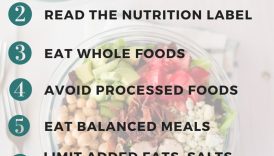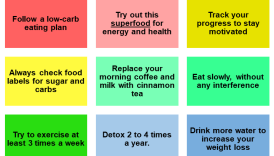The Secrets to Sustaining a Good Healthy Lifestyle Long-Term

Introduction to Sustaining a Good Healthy Lifestyle Long-Term
Understanding the Importance of Long-Term Health
Sustaining a good healthy lifestyle is not merely about fitting into a dress size or achieving a specific fitness goal; it’s about nurturing the body and mind for the long haul. As life progresses, making choices that support long-term health can help ward off chronic diseases and enhance overall quality of life. For instance, incorporating regular physical activity and balanced nutrition can significantly reduce risks associated with heart disease and diabetes. Just think about your own life—how much easier is it to engage with family and friends when you feel vibrant and full of energy?
- The Secrets to Sustaining a Good Healthy Lifestyle Long-Term
- Introduction to Sustaining a Good Healthy Lifestyle Long-Term
- Understanding the Importance of Long-Term Health
- Benefits of Consistency in Healthy Living
- Setting Realistic Health Goals
- Creating Achievable Objectives
- Tracking Progress and Adjusting Goals
- Developing Healthy Eating Habits
- Balanced Nutrition for Long-Term Health
- Incorporating Superfoods into Your Diet
- Regular Physical Activity
- Finding Exercises You Enjoy
- Building a Sustainable Workout Routine
- Prioritizing Mental Health
- Practices for Mindfulness and Stress Management
- Importance of Adequate Sleep
- Establishing Support Systems
- Surrounding Yourself with Positive Influences
- Seeking Professional Help When Needed
- Creating Healthy Habits in Daily Life
- Incorporating Movement Throughout the Day
- Meal Prep and Planning for Success
- Avoiding Fad Diets and Quick Fixes
- Understanding the Pitfalls of Short-Term Solutions
- Embracing Long-Term Lifestyle Changes
- Managing Social and Environmental Influences
- Navigating Peer Pressure and Temptations
- Creating a Healthy Environment at Home and Work
- Celebrating Small Wins and Staying Motivated
- Recognizing Progress Along the Way
- Rewarding Yourself for Healthy Choices
Benefits of Consistency in Healthy Living
Consistency is the linchpin in living a healthy lifestyle. A few key benefits include:
- Improved Energy Levels: Regular exercise and a nutritious diet can result in increased stamina and vitality.
- Mental Clarity: Balanced nutrition and exercise contribute to better cognitive functions.
- Increased Resilience: A consistent routine builds strength, both physically and emotionally.
By focusing on small, manageable changes each day, sustaining a healthy lifestyle becomes not only achievable but also rewarding. Celebrate those daily victories, and you’ll find yourself on a path toward lifelong wellness.
Setting Realistic Health Goals
Creating Achievable Objectives
Once you appreciate the importance of a healthy lifestyle, the next step is setting realistic health goals. This process begins with understanding your current situation and envisioning where you want to be. Start small, and build upon those minor victories. For example, instead of saying, “I want to lose 30 pounds,” try, “I want to lose 1 pound this week.” Consider these tips for creating achievable objectives:
- Be Specific: Instead of a vague goal like “get fit,” say “exercise for 30 minutes, three days a week.”
- Make Them Measurable: Use numbers to track your progress, whether it’s steps taken or servings of vegetables consumed.
- Set Time Frames: Give yourself deadlines, which increase accountability.
Tracking Progress and Adjusting Goals
Tracking your progress is vital for staying motivated. Utilize a journal or apps to log your meals, workouts, and overall mood. This reflection not only highlights your achievements but also helps you identify areas needing improvement.
- Weekly Reviews: Take time each week to assess how well you’re meeting your goals.
- Be Flexible: If a goal feels out of reach, it’s okay to adjust. Life happens, and adapting is part of the journey.
By regularly fine-tuning your objectives, you can maintain momentum, ensure sustainability, and celebrate each step of your health journey.
Developing Healthy Eating Habits
Balanced Nutrition for Long-Term Health
Building a healthy lifestyle means embracing balanced nutrition. Imagine your body as a car; just as a car runs smoothly on quality fuel, your body performs best with nutritious foods. Balanced nutrition involves a mix of carbohydrates, proteins, and healthy fats, each playing a significant role in your overall well-being. To create a balanced plate, consider these tips:
- Fill Half Your Plate with Vegetables and Fruits: They provide essential vitamins and minerals.
- Choose Whole Grains: Such as quinoa, brown rice, and whole wheat products over refined grains.
- Incorporate Lean Proteins: Options like chicken, fish, beans, and legumes help muscle recovery and maintenance.
Incorporating Superfoods into Your Diet
Superfoods are a fantastic way to enhance your nutrition. These nutrient-rich foods can help boost immunity and support long-term health. For instance, adding foods like quinoa, blueberries, or spinach can elevate your meals. Here’s a quick list of superfoods to consider:
- Kale: Packed with vitamins A, K, and C.
- Chia Seeds: Rich in omega-3 fatty acids and fiber.
- Greek Yogurt: A great source of protein and probiotics.
By gradually incorporating these superfoods, you’ll not only enrich your diet but also make eating a delicious and nourishing experience. Your future self will thank you for the energy and vitality these choices bring!
Regular Physical Activity
Finding Exercises You Enjoy
As you commit to developing healthy eating habits, incorporating regular physical activity is the next logical step in your wellness journey. The key here is to discover exercises that you genuinely enjoy. If you’re dreading your workout, you’re less likely to stick with it long-term! Think about activities you’ve liked in the past. Maybe it was dancing, cycling, or even hiking. Here are some tips to help you find your groove:
- Try Different Classes: Attend yoga, kickboxing, or spin classes to see what excites you.
- Get Outside: Nature walks, jogging, or outdoor sports can make workouts feel more refreshing.
- Involve Friends or Family: Socializing while exercising can enhance your enjoyment and motivation.
Building a Sustainable Workout Routine
Once you’ve identified exercises you enjoy, it’s time to build a sustainable workout routine. Aim for consistency by scheduling your workouts like any other important commitment.
- Set Clear Days and Times: Designate specific times each week for your workouts.
- Mix It Up: Avoid monotony by alternating between different types of activities, such as strength training, cardio, and flexibility exercises.
- Listen to Your Body: Rest days are essential for recovery. Don’t hesitate to adjust your routine to prevent burnout or injury.
By finding joy in movement and establishing a routine that suits your lifestyle, regular physical activity will become a rewarding part of your daily life. You’ll not only improve your physical health but also boost your mood and mental clarity.
Prioritizing Mental Health
Practices for Mindfulness and Stress Management
As you establish a solid foundation of physical activity, it’s crucial not to overlook mental well-being. Prioritizing mental health is essential for overall happiness and balance in life. One of the most effective tools for this is mindfulness. By practicing mindfulness, you can gain a deeper awareness of your thoughts and feelings, which helps in managing stress. Here are a few practical mindfulness techniques to try:
- Meditation: Spend just 5-10 minutes daily in a quiet space, focusing on your breath.
- Gratitude Journaling: Write down three things you’re grateful for each day to shift your mindset.
- Deep Breathing Exercises: Practice inhaling slowly through your nose and exhaling through your mouth to soothe anxiety.
Importance of Adequate Sleep
Just as mindfulness plays a significant role in mental health, so does sleep. Adequate sleep is often underestimated but is crucial for both mental and physical recovery. Lack of sleep can lead to irritability, increased stress, and even hinder your motivation to maintain a healthy lifestyle. Aim for 7-9 hours of sleep per night by:
- Establishing a Sleep Schedule: Go to bed and wake up at the same time every day, even on weekends.
- Creating a Relaxing Bedtime Routine: Wind down with activities like reading, stretching, or taking a warm bath.
- Limiting Screen Time Before Bed: Reduce blue light exposure to improve sleep quality.
By prioritizing mental health through mindfulness practices and ensuring adequate sleep, you will pave the way for a balanced and fulfilling life, complementing your journey to a healthy lifestyle.
Establishing Support Systems
Surrounding Yourself with Positive Influences
As you delve deeper into prioritizing mental health, establishing a strong support system becomes crucial. The people you surround yourself with can significantly impact your overall well-being and motivation. Think about your circle—are they supportive and uplifting? To foster a positive environment, consider these strategies:
- Seek Out Uplifting Friends: Spend time with those who encourage your goals and inspire you to be your best self.
- Join Support Groups: Engage with communities, whether in person or online, that share similar interests or challenges.
- Limit Negative Interactions: Reassess connections that drain your energy or discourage your progress.
Seeking Professional Help When Needed
While a strong support network is invaluable, don’t hesitate to seek professional help when necessary. Talking to a counselor or therapist can provide you with tools and insights to navigate challenges more effectively. Here’s when to consider professional support:
- Overwhelming Stress or Anxiety: If everyday tasks feel unmanageable, a professional can provide coping strategies.
- Major Life Changes: Whether it’s a loss, a career shift, or a relationship change, don’t shy away from seeking guidance.
- Goal Setting: A therapist can help you clarify your goals and develop actionable steps to achieve them.
By surrounding yourself with positive influences and being open to professional help, you create a solid foundation for achieving your health goals and maintaining a balanced lifestyle.
Creating Healthy Habits in Daily Life
Incorporating Movement Throughout the Day
Building on the importance of support systems, creating healthy habits in daily life is key in making long-term wellness achievable. One effective method is incorporating movement throughout your day. Remember, not every workout has to be a gym session; small adjustments can lead to significant benefits. Here are some ideas to increase your daily activity:
- Take the Stairs: Opt for stairs over elevators wherever possible.
- Stand or Walk During Calls: If you’re on a phone call, move around or stand to break the sedentary routine.
- Set a Timer: Aim for a quick stretch or short walk every hour to keep your energy levels up.
Meal Prep and Planning for Success
Another vital aspect of healthy daily habits is meal prep and planning. By dedicating some time each week to prepare nutritious meals, you can avoid the temptation of unhealthy choices. Consider these meal prep tips:
- Plan Your Weekly Menu: Outline meals for the week to streamline grocery shopping and cooking.
- Batch Cooking: Prepare large portions of grains, proteins, or sauces that can be used in different meals.
- Flexible Snacks: Pre-portion healthy snacks like fruits, nuts, or yogurt to ensure they’re easily accessible.
By incorporating movement into your day and prioritizing meal prep, you create a strong foundation for healthy habits that can easily slot into your lifestyle, enhancing your journey toward wellness.
Avoiding Fad Diets and Quick Fixes
Understanding the Pitfalls of Short-Term Solutions
As you continue to establish healthy habits, it’s essential to steer clear of fad diets and quick fixes. While it might be tempting to follow the latest trend that promises rapid weight loss or perfect health, these methods often backfire. Many people find that the results are not sustainable and can lead to frustration. Here’s why you should be cautious:
- Nutrient Deficiency: Fad diets may eliminate essential food groups, leading to a lack of vital nutrients.
- Yo-Yo Dieting: Rapid weight loss often results in regaining the weight back, causing a cycle of disappointment.
- Unrealistic Expectations: Quick fixes can create unrealistic standards for health, leading to feelings of inadequacy.
Embracing Long-Term Lifestyle Changes
Instead of focusing on temporary measures, embrace long-term lifestyle changes that promote sustainable health. Think about making gradual adjustments that fit seamlessly into your life. Consider these strategies:
- Mindful Eating: Listen to your body and eat when you’re hungry. Focus on portion control.
- Focus on Whole Foods: Aim for fruits, vegetables, lean proteins, and whole grains as staples in your diet.
- Set Manageable Goals: Break your overall health objectives into smaller, achievable milestones.
By prioritizing lifestyle changes over quick fixes, you pave the way for lasting wellness and satisfaction. This approach not only helps you achieve your health goals but also cultivates a fulfilling and balanced life.
Managing Social and Environmental Influences
Navigating Peer Pressure and Temptations
With a solid foundation in avoiding fad diets and embracing long-term lifestyle changes, the next step is managing social and environmental influences. Navigating peer pressure and temptations can be challenging, especially in social settings where unhealthy options abound. To stay on track, consider these strategies:
- Be Honest About Your Goals: Share your health journey with friends and family, creating accountability.
- Practice Saying No: Develop a kind but firm way to decline unhealthy foods or drinks when you feel pressured.
- Suggest Healthier Alternatives: If dining out, propose restaurants with nutritious options; this not only helps you but also introduces others to healthier choices.
Creating a Healthy Environment at Home and Work
Creating a supportive environment can also significantly impact your success. At home and work, small changes can cultivate a healthier atmosphere. Here are some ideas to implement:
- Stock Healthy Snacks: Keep fruits, nuts, and whole-grain snacks available to curb cravings.
- Designate a Workout Area: Create a space at home for physical activity, even if it’s a small corner for yoga or stretching.
- Use Reminders: Hang motivational quotes or visuals in your workspace to encourage healthy habits.
By effectively managing social influences and curating a healthy environment, you enhance your ability to maintain your health journey, thus reinforcing your commitment to a balanced lifestyle.
Celebrating Small Wins and Staying Motivated
Recognizing Progress Along the Way
As you navigate your health journey and manage social and environmental influences, it’s vital to celebrate the small wins along the way. Recognizing progress, no matter how minor, can significantly boost your motivation and reinforcement for your healthy choices. Consider keeping a progress journal where you jot down achievements, big or small. This could include:
- Exercising Consistently: Completing a week of workouts or trying a new fitness class.
- Eating Balanced Meals: Preparing home-cooked meals for most of the week.
- Mental Health Breaks: Taking time for mindfulness or relaxation techniques regularly.
Acknowledge these moments, as they serve as reminders of how far you’ve come.
Rewarding Yourself for Healthy Choices
To further reinforce your positive behavior, set up a reward system for yourself. These rewards don’t have to be food-related; instead, think of experiences or items that enhance your wellness journey. Examples of rewards might include:
- Spa Day: Treating yourself to a massage or facial after reaching a fitness goal.
- Fitness Gear: Investing in new workout clothes or equipment when you’ve consistently exercised for a month.
- Special Outing: Planning a fun day trip or social event that excites you when you make healthier choices.
By celebrating your progress and rewarding yourself for healthy decisions, you will cultivate a sense of accomplishment and maintain the motivation to continue on your path toward long-term health and well-being.





